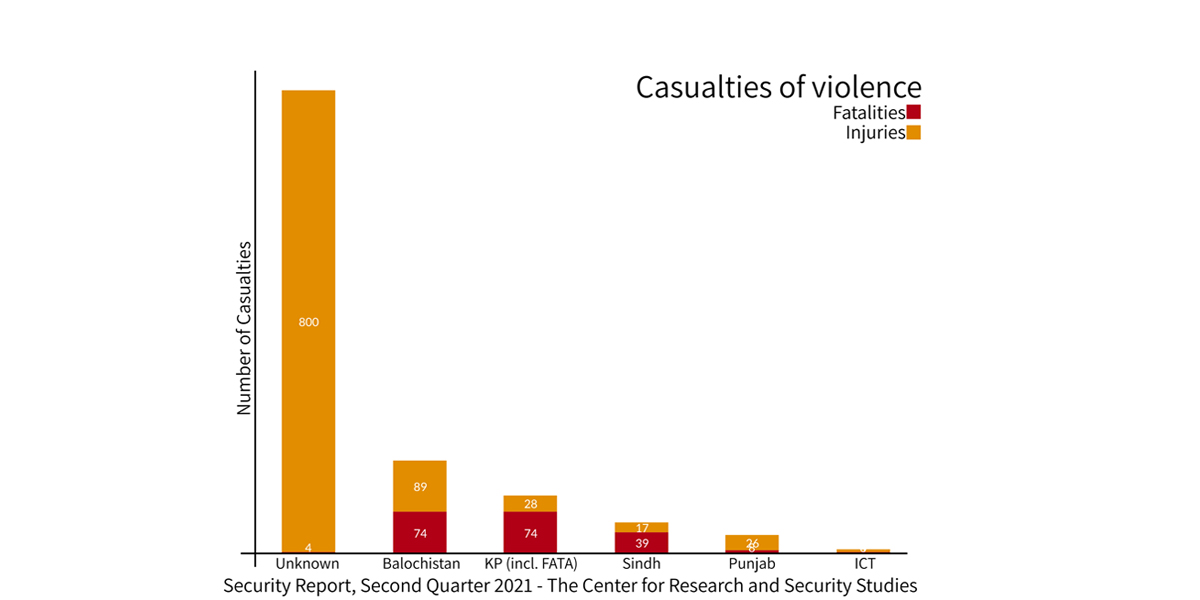April 1, 2021 to June 31, 2021
by Senior Research Fellow M. Nafees
A total of 1,169 casualties resulted from various forms of violence during Q2, 2021 (April – June). Of these, 203 lost their lives and 966 were wounded. An unprecedented upsurge in the number of wounded persons was the result of the countrywide violent protest by the Tehreek-e-Labbaik Pakistan (TLP) on a blasphemy-related issue that left 4 persons dead and 800 wounded. The highest number of fatalities from violence was in Balochistan (74), erstwhile FATA (39), Sindh (39), KP (35), Punjab (8), Islamabad (4), and 4 additional persons in locations unknown* (see table 1 below) as victims of violence carried out by TLP protestors in April.

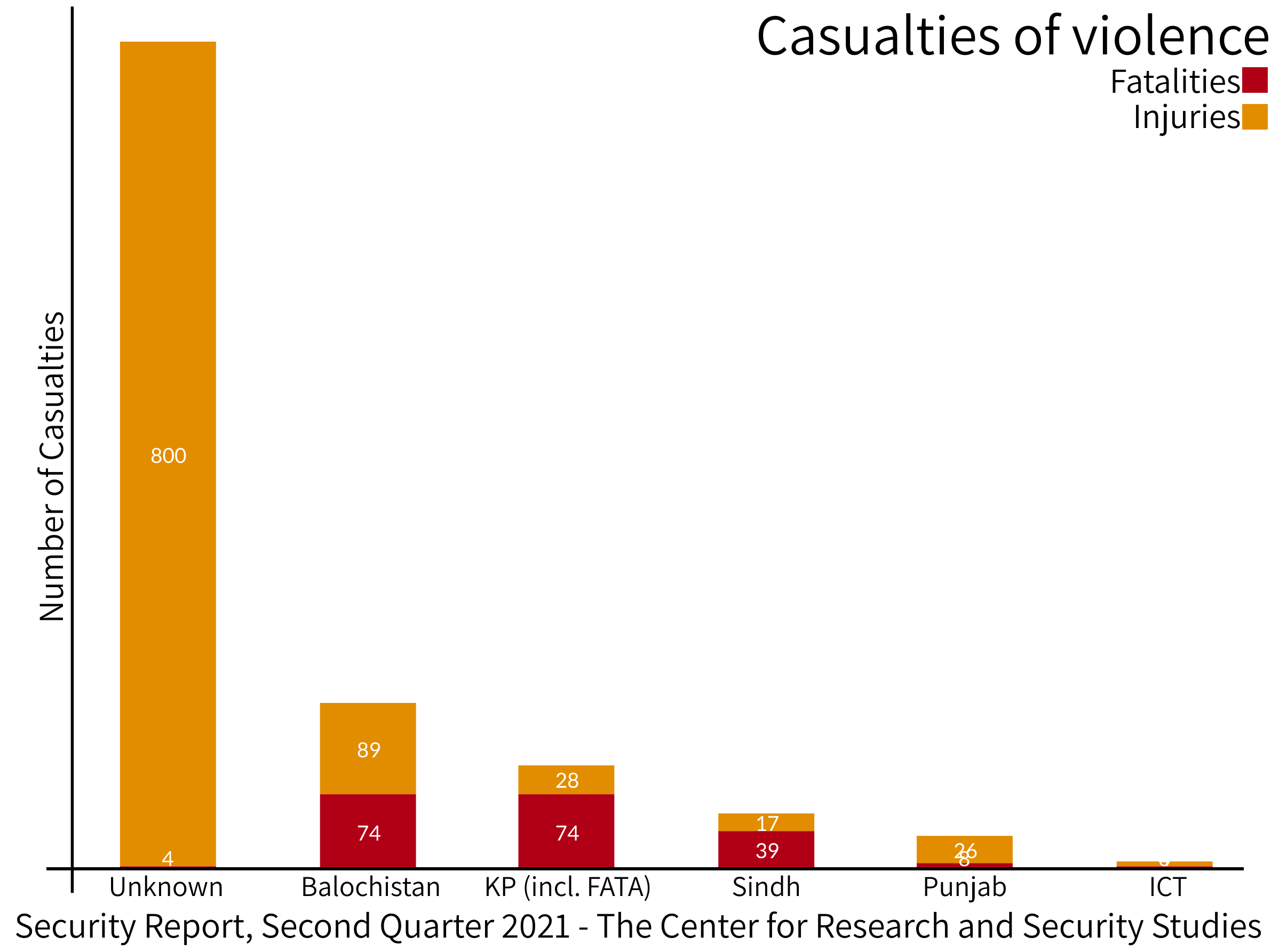
If we combine the KP and erstwhile FATA fatalities, the equal that of Balochistan at 74. While Punjab and former FATA experienced a significant drop in violence (down by 64% and 43% respectively), Balochistan and Sindh witnessed a 50%+ uptick in violence. KP (excluding FATA) had marginal surge of 9% this quarter (table 2).

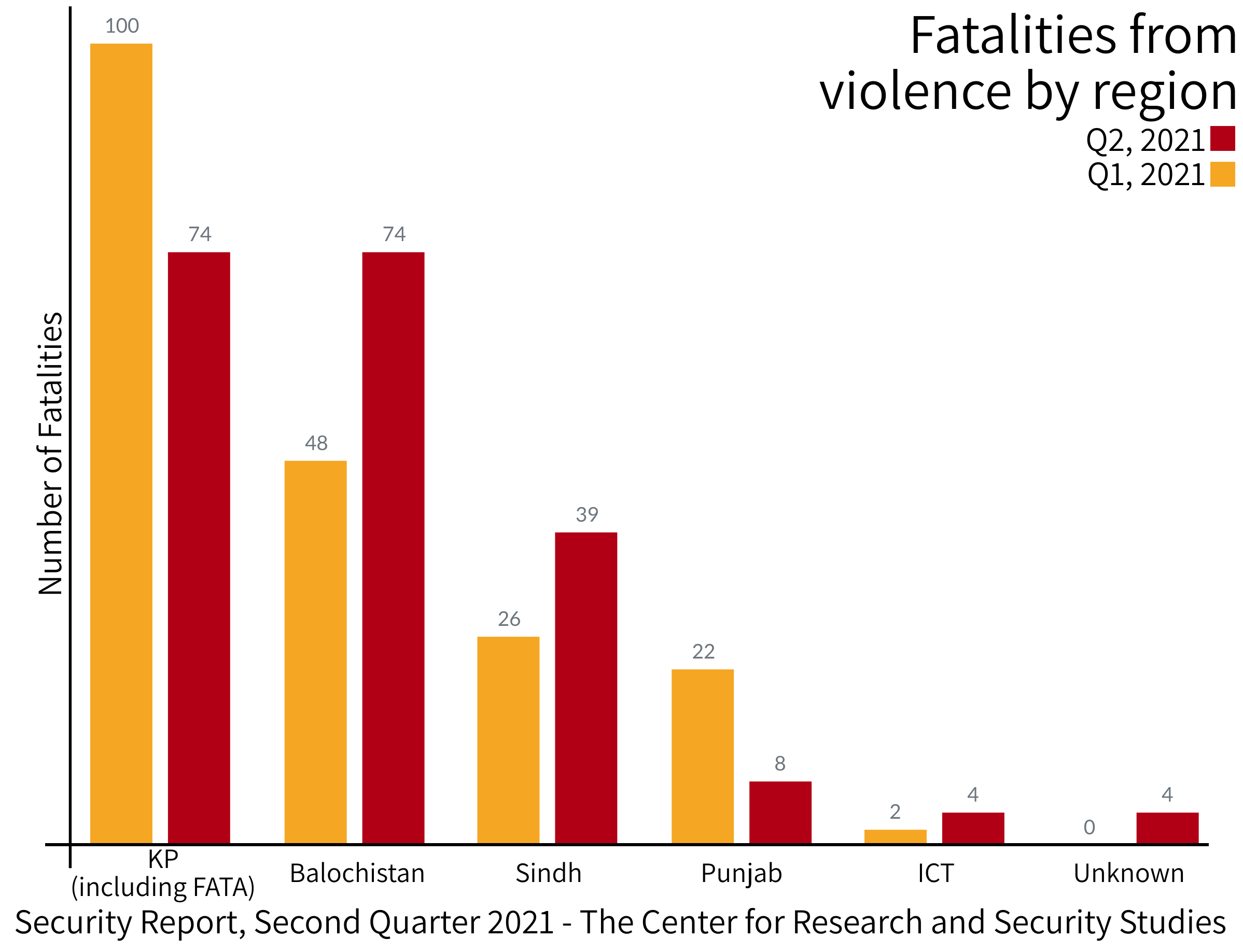
April was the only month when a drop in violence was witnessed (22%), while the next two months (May and June) showed a rise in the number of fatalities during Q2 when compared with Q1 (table 3).

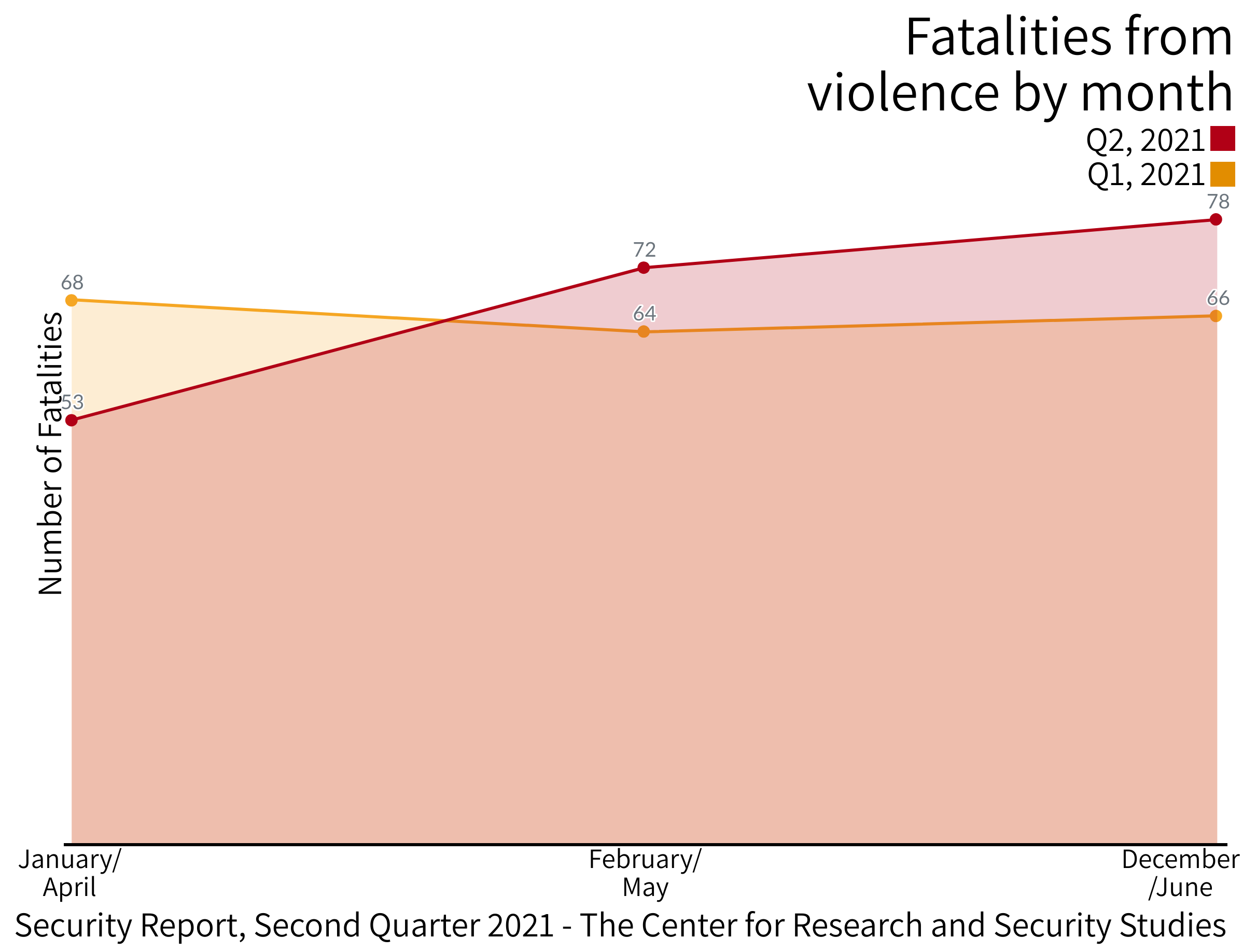
Data by Districts
Quetta, the provincial capital of Balochistan, suffered the most from violence during Q2, 2021 losing 26 lives while the North Waziristan district of former FATA witnessed a notable decline this quarter as it lost 25 lives compared to 46 in previous quarter. Karachi, Kohat, and Bolan were the three districts where fatalities from violence were in the double digits (19, 16, and 11 respectively). South Waziristan, Peshawar, and Machh regions had a sharp drop in violence this quarter (2, 1, 0 respectively).

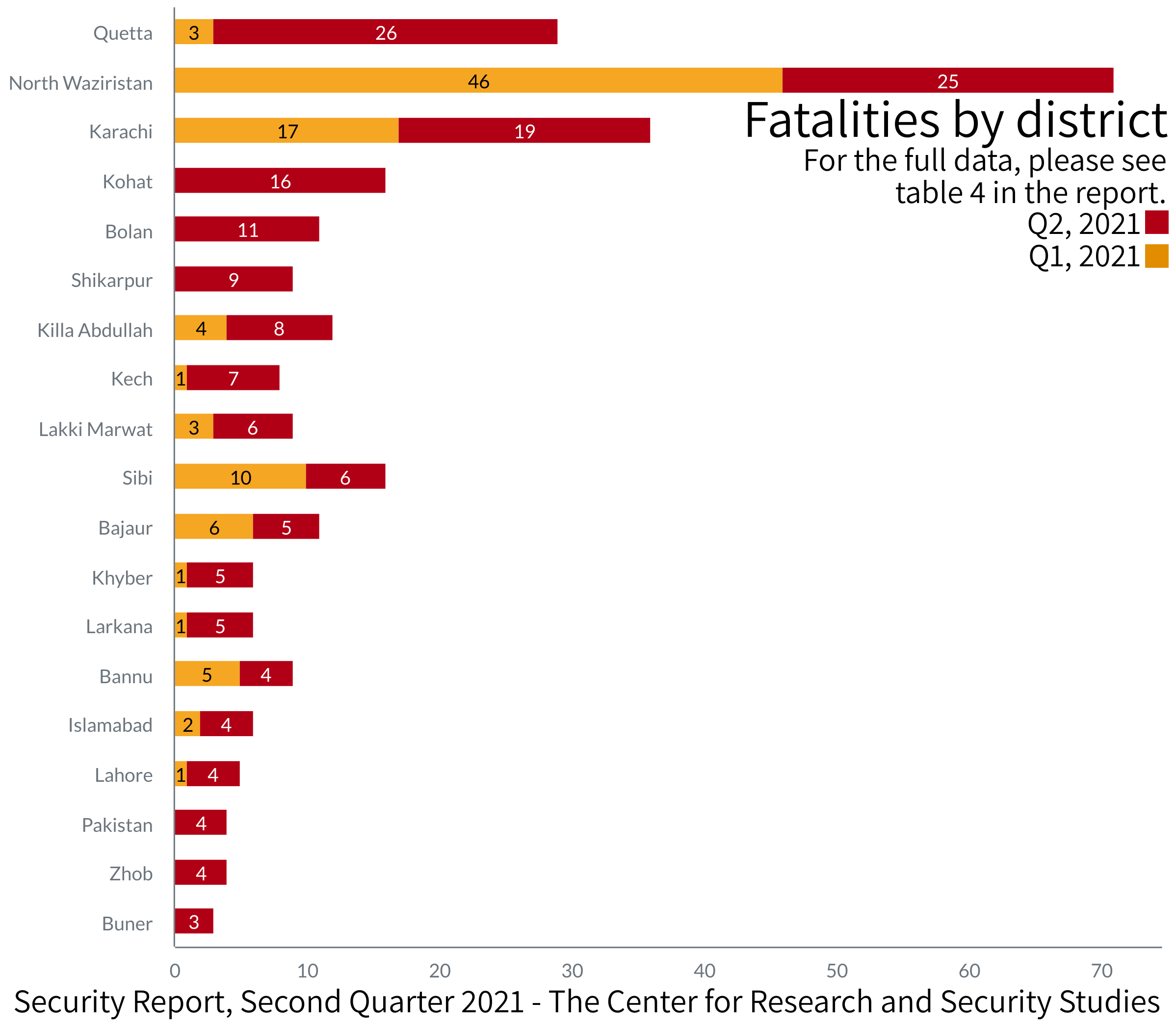
Data by Methods
The use of guns for target killing remained the most common form of violence and all regions of the country were affected by it. In KP (including former FATA), the targets of this violence were a leader of the Awami National Party (ANP), a former member of Peace Committee, and a lawyer besides some other unknown civilians. The frequency of armed attacks increased this quarter.
The number of ground operations carried out by the security forces dropped from 19 in Q1 to 13 in Q2 resulting in drop of the fatalities of outlaws from such operations. Some ground operations experienced failures in achieving their targets resulting in demise of five security personnel.
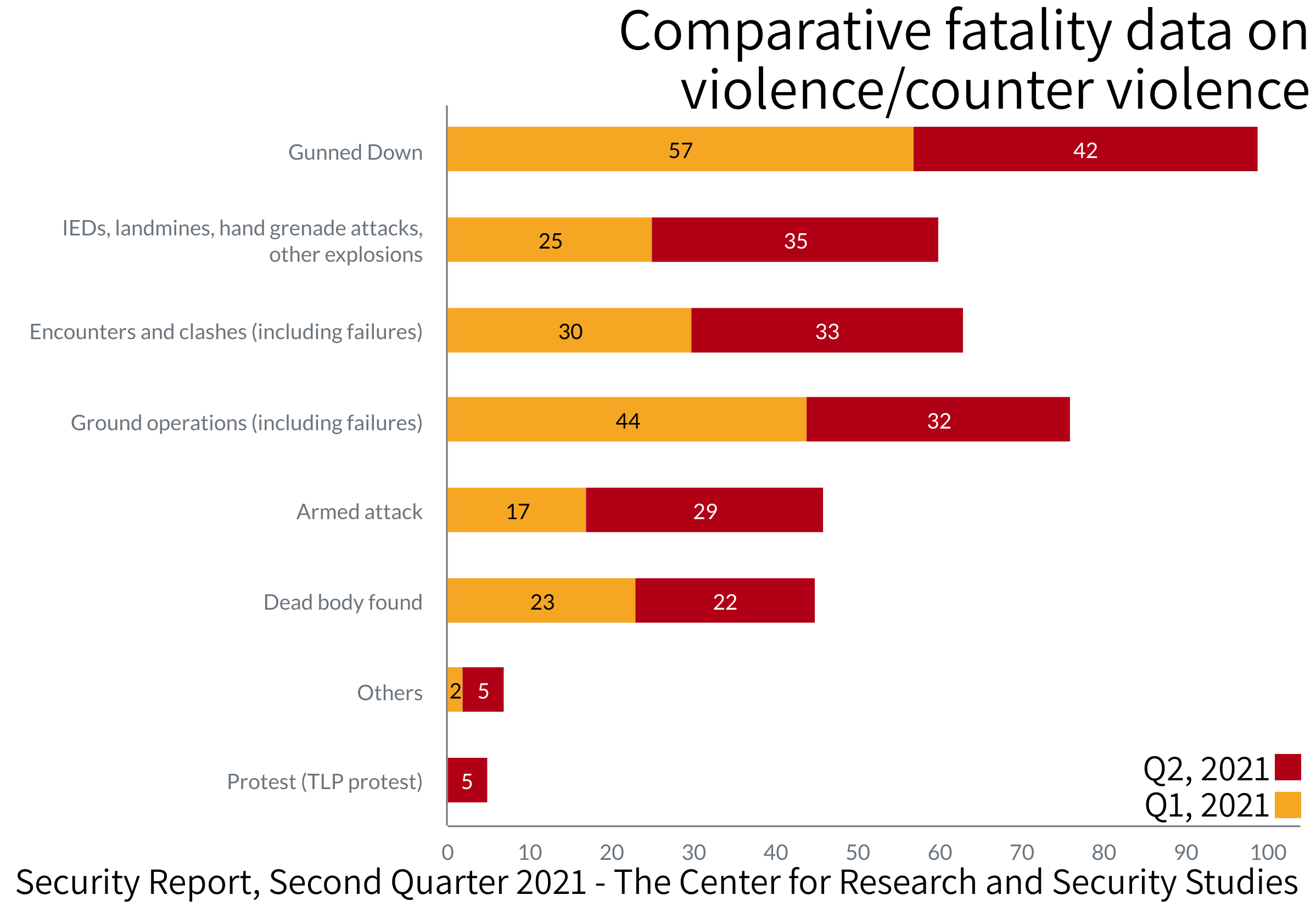
A slight drop in findings of dead bodies was recorded this quarter but the issue of dead bodies and target killing in Bannu continued to compel the local population to stage sit-ins, protests, and a long march. The findings of the bullet-riddled bodies of four youngsters had triggered a sit-in on March 21, 2021 and ended on 30 March 2021. Later, on 1 June 2021, a tribal elder, Malik Naseeb Khan, was shot dead in Janikhel area of Bannu. The relatives of the slain elder and tribesmen placed his body in front of the police station to demand immediate arrest of the killers. This protest continued for more than 20 days and then the protesters launched a march towards Islamabad resulting in clash with the police that cost lives of three protesters. On 27 June 2021, the protest ended after some agreement between the protesters and the government.
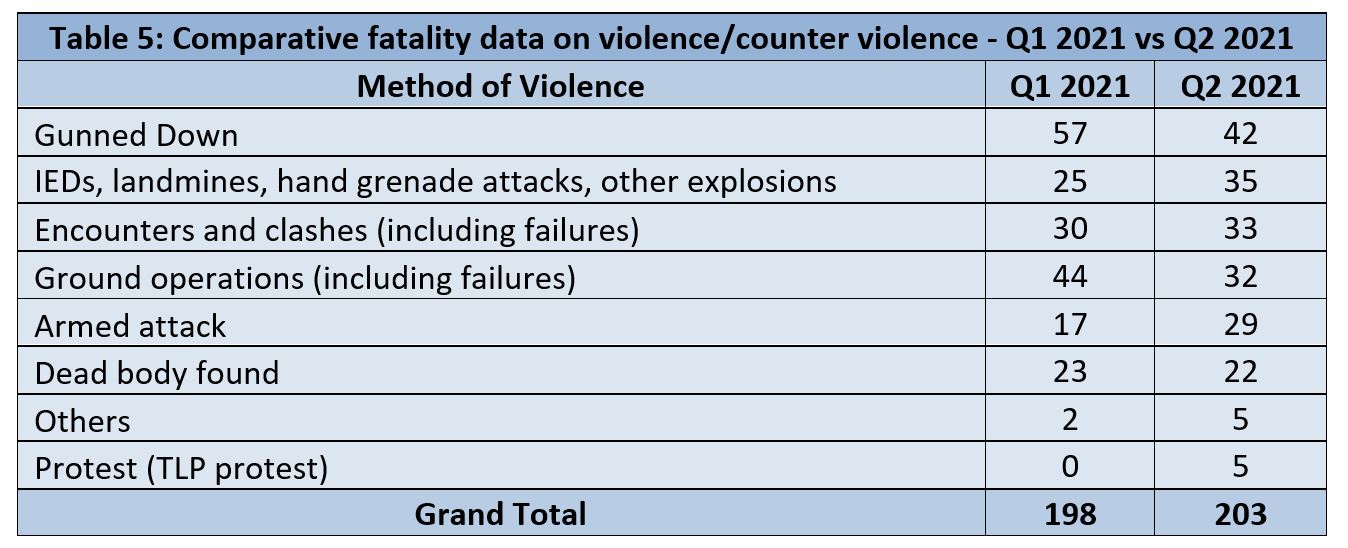
The encounters of law enforcement agencies with the outlaws went up in Q2 but, the failure of some encounters cost lives of three security personnel while the number of suspected encounters remained unchanged.
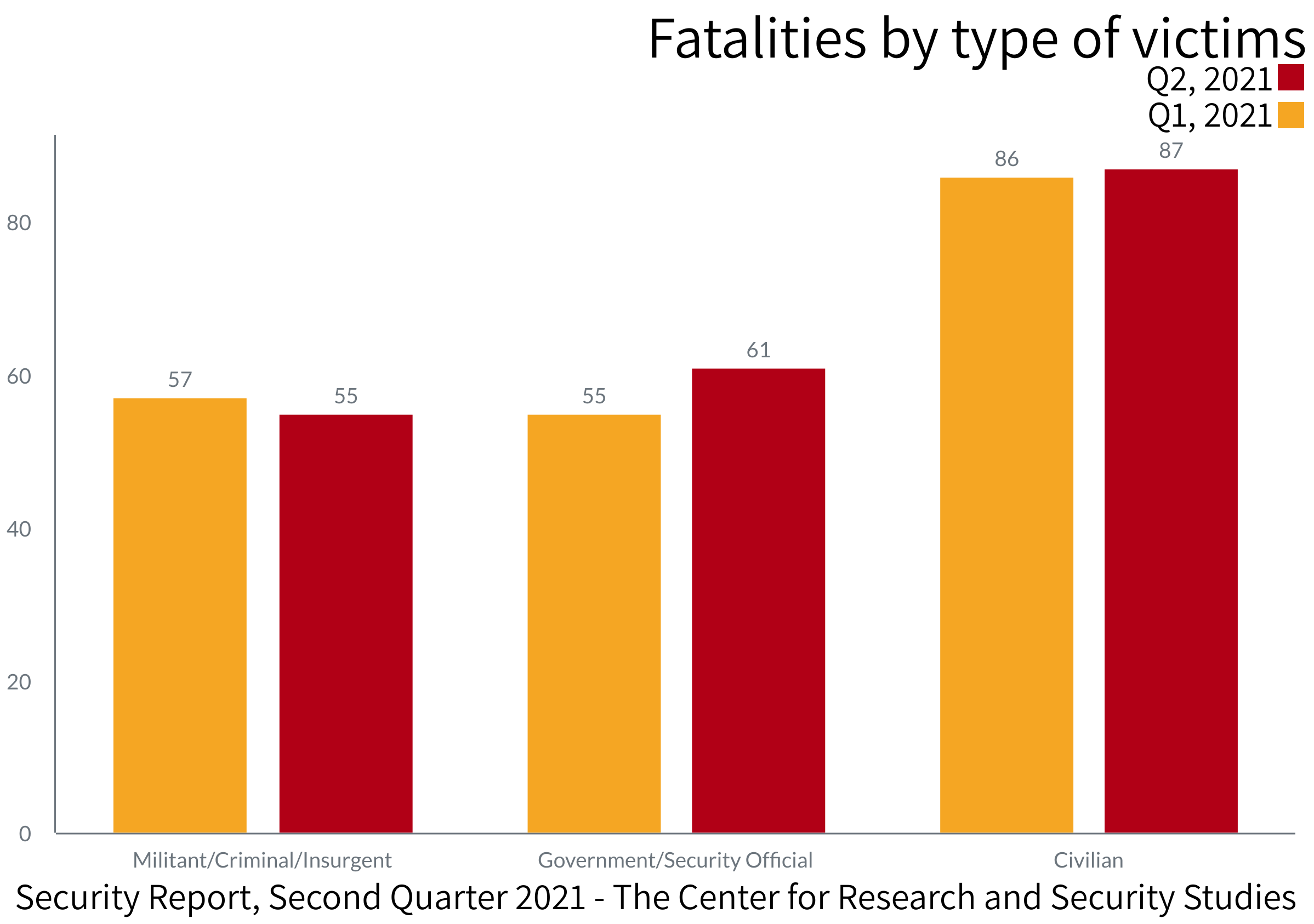
Use of explosive materials like bomb, IED, rockets, and hand grenade went up this quarter causing the loss of 35 lives. Five persons including three children, one woman, and man were the victims of a mortar shell explosion in Landi Kotal as the children had brought home an unexploded mortar from outside. An explosive laden car was detonated in Lahore near the residence of the chief of Jamat-ud-Dawa on 23 June 2021.
Data by Victims
Civilians bore the brunt of violence this quarter. The outlaws (militants, criminals, and insurgents) also witnessed a negligible drop in the number of their fatalities and the percentage as well. The fatalities of security personnel were lower than the civilian’s fatalities and so was their percentage. However, security personnel’s fatalities accounted for 30% of the total fatalities, an alarming situation that appears to be a resultant effect of the US withdrawal from Afghanistan. The combined percentage of the civilian and security personnel is 73% in Q2 as compared to 71% in Q1.
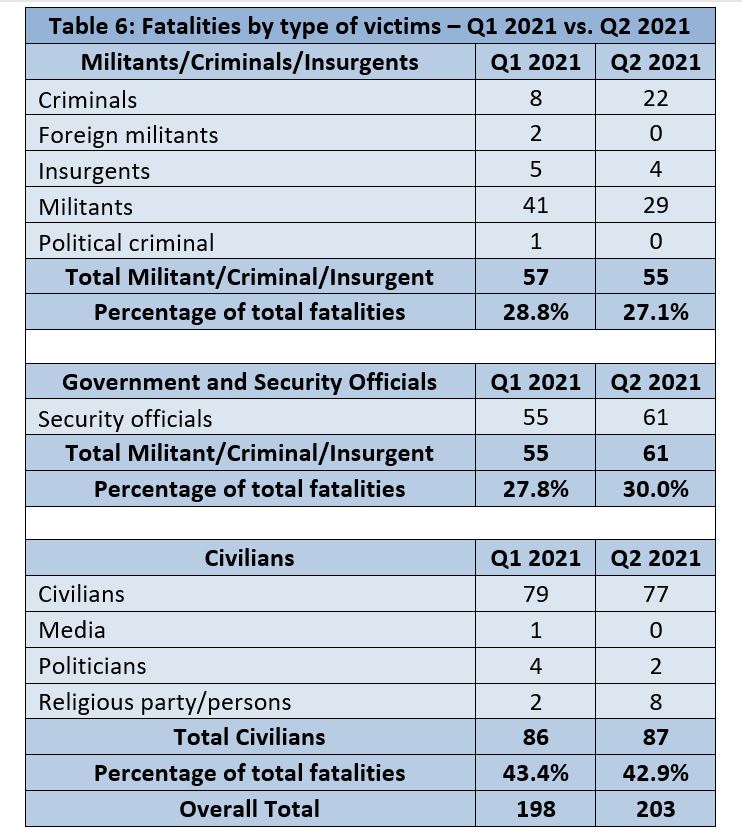
Data by Claimants
A number of attacks were carried out by unknown militants. However, TTP appeared to have increased its operations in the country as the number of fatalities from their attacks went up from 4 in Q1 to 7 in Q2. Afghan based militants, considered to be the remnants of the TTP who were forced to flee away to Afghanistan during Zarb-e-Azb operations, have also increased their attacks along the Pak-Afghan borders targeting the security forces that are engaged in fencing the border area. The ongoing withdrawal of the US forces from Afghanistan is also one of the reasons for an escalation in such attacks.
Insurgent groups like BLA, BLF, and BRA also carried out attacks that left 6 persons dead in Q2 as against 3 in Q1. The gangs of dacoits in Kutcha area of South Punjab have also increased their violence in the region. On 26 May, 2021, they kidnapped three policemen and killed two of them. A large-scale police operation was carried out against the gang to get the abducted persons released. One 3 June 2021, police managed to get the abducted policemen released by the gangsters using the influence of local tribal leaders. Even after the release of policemen, Deputy Inspector General (DIG) Rana Faisal remained committed to continue the operation until the arrest of last gangster in the riverine area of Rujhan. However, no further reports appeared of the operation after the safe recovery of abducted policemen.
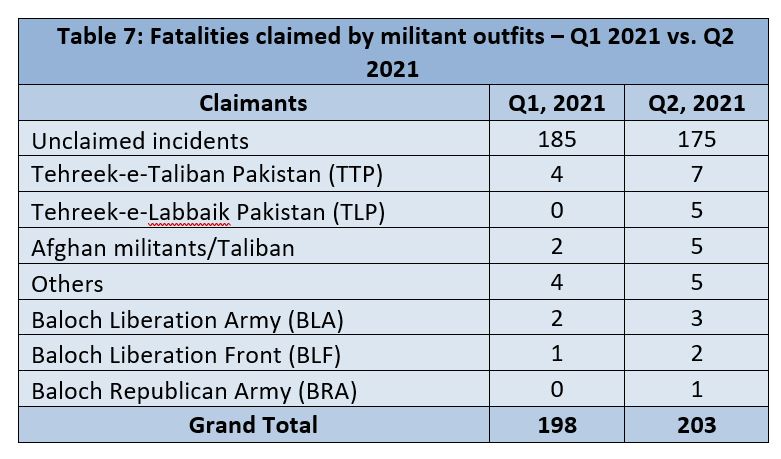
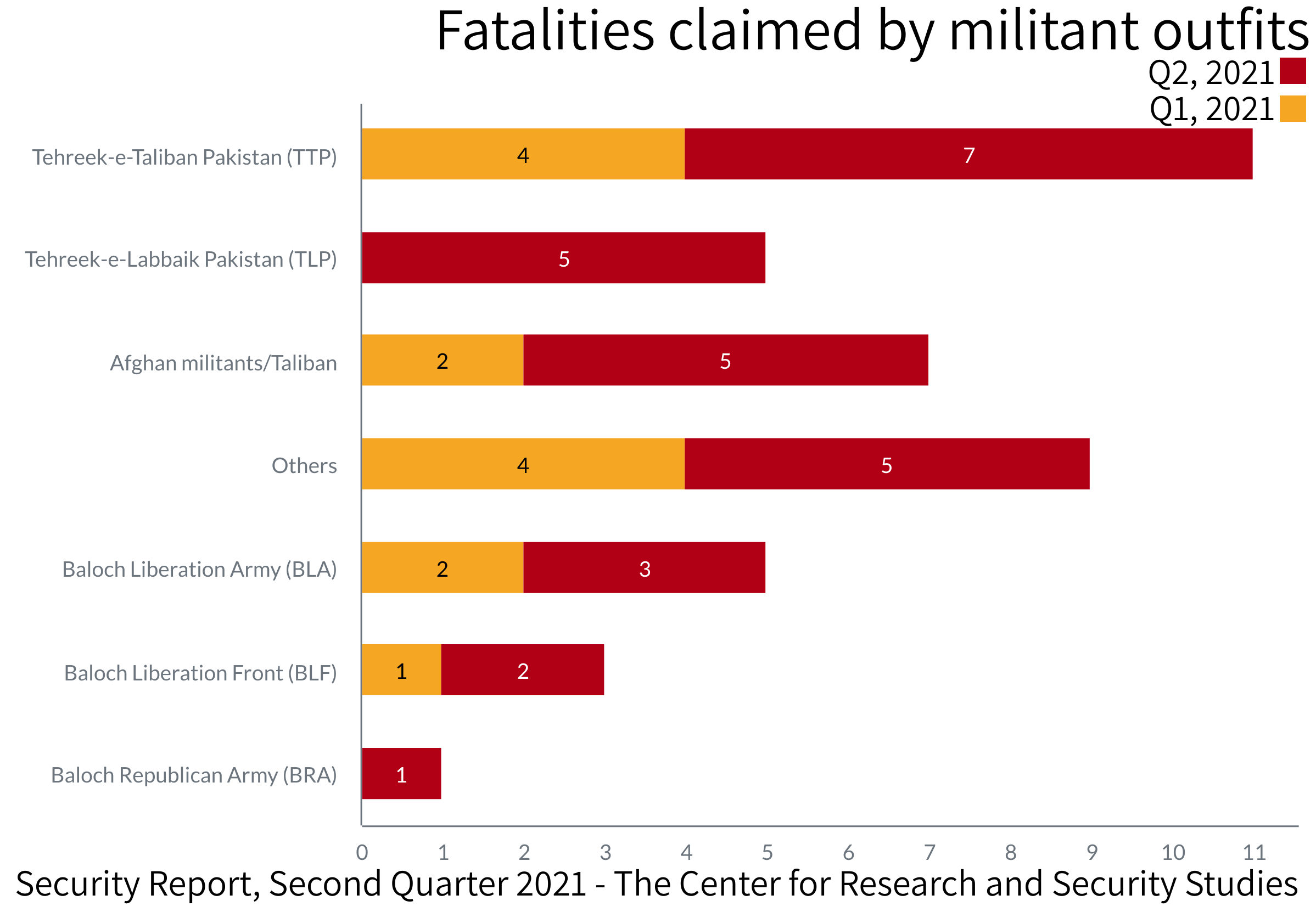
Data by Sectarianism
The sectarian or religiously-motivated violence in Q2, 2021 left 7 people dead and 805 wounded. This is the highest number of sectarian casualties that was ever reported in the country in a single quarter within the last decade. Most of the casualties were from violence that erupted during the protest staged by the TLP in the month of April seeking ouster of the French Ambassador from Pakistan.
Alarmed by the violent riots Prime Minister Imran Khan appeared on the television and referring to the protest demonstrations by TLP, he said that the riots had killed four policemen and injured over 800, while 40 police vans were gutted besides damage to private properties. He said that not even during the worst terrorist attacks did the security officials suffer such a highest number of casualties.
As Khan’s address to the nation was the only source of information about the total number of casualties, we reflected the number against the whole country as Pakistan. The violence against other sects and religions was also reported in the press and the highest casualties of such violence were in Balochistan, followed by Islamabad and Sindh. One of the policemen wounded in TLP riots succumbed to his injury in Hafizabad one week after the incident.
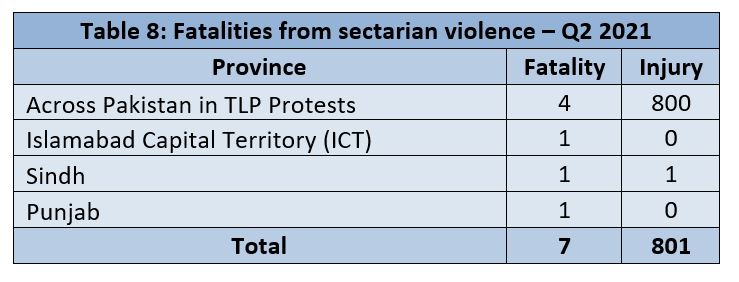
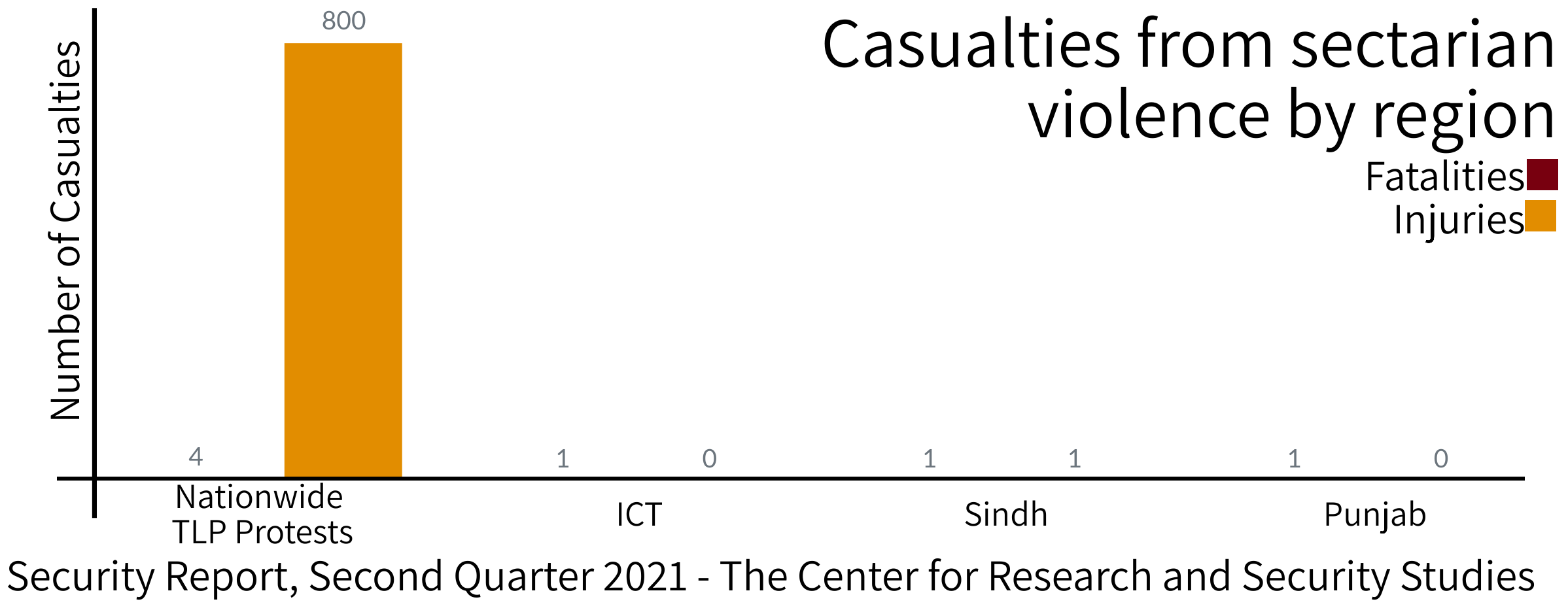
Other than the casualties of TLP riots, two Hindus appeared to be the victims of sectarian violence in Q2 2021; one of them was a Hindu driver of Pakistan Tehreek-e-Insaaf (PTI) Member National Assembly (MNA) Lal Chand in Islamabad, and the other was a Hindu trader Ashok Kumar in Khuzdar who became target because of his refusal to pay extortion money; Hindu communities are easy targets because of historically weak state response. A man was injured in an IED explosion close to a seminary, Darul Uloom Sharia, near Satellite Town, Quetta.
The fatalities from sectarian violence dropped from 14 in Q1 to 7 in Q2, a significant drop in such violence if the TLP violence is excluded.


